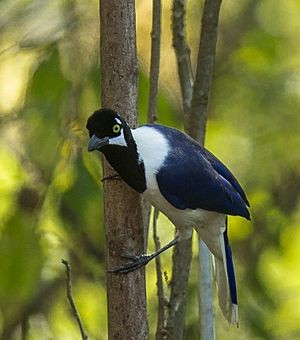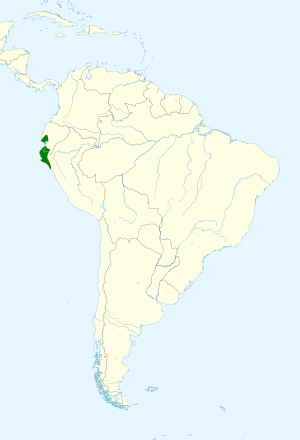White-tailed jay facts for kids
Quick facts for kids White-tailed jay |
|
|---|---|
 |
|
| Conservation status | |
| Scientific classification | |
| Genus: |
Cyanocorax
|
| Species: |
mystacalis
|
 |
|
The white-tailed jay (Cyanocorax mystacalis) is a beautiful bird that belongs to the Corvidae family. This family includes other smart birds like crows and magpies. You can find this special jay living in the warm countries of Ecuador and Peru.
This bird loves to live in certain types of forests. It prefers subtropical or tropical dry forests and subtropical or tropical moist lowland forests. These are places with lots of trees and often a warm, humid climate.
Contents
What Does It Look Like?
The white-tailed jay gets its name from its striking white tail. It has bright blue and black feathers, making it quite noticeable in its forest home.
One interesting thing about this bird is that it shows no sexual dimorphism. This means that male and female white-tailed jays look exactly the same. You can't tell them apart just by looking at their feathers or size!
What Does It Eat?
The white-tailed jay is an omnivore, which means it eats both plants and animals. However, it mostly enjoys eating insects. It likes to search for its food out in the open. Its favorite snacks include beetles, ants, and other small insects it finds on the ground or in trees.
Sounds and Calls
If you were in the forest where these jays live, you might hear their unique sound. They make a vocal, repetitive, and hollow call. It's a distinct sound that helps them communicate with other jays in their group.
Where Does It Live?
The white-tailed jay is native to South America. Its main homes are in the western parts of Ecuador and Peru. These areas are known for their rich biodiversity and diverse forest ecosystems. The specific types of forests it lives in provide the perfect environment for it to find food and build its nests.
Conservation Status
The white-tailed jay is currently listed as "Least Concern" (LC) by the International Union for Conservation of Nature (IUCN). This means that, for now, its population is stable and not considered to be at high risk of extinction. However, like many forest animals, its habitat can be threatened by deforestation and other human activities. Protecting its forest homes is important for its future.
See also
 In Spanish: Chara coliblanca para niños
In Spanish: Chara coliblanca para niños


